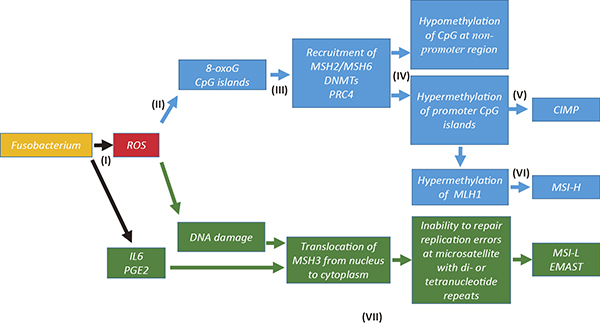- 著者
- Minoru Koi Yoshiki Okita John M. Carethers
- 出版者
- The Japan Society of Coloproctology
- 雑誌
- Journal of the Anus, Rectum and Colon (ISSN:24323853)
- 巻号頁・発行日
- vol.2, no.2, pp.37-46, 2018-04-25 (Released:2018-04-26)
- 参考文献数
- 82
- 被引用文献数
- 46
It has been recently reported that the population of Fusobacterium, particularly Fusobacterium nucleatum (Fn), is overrepresented in colorectal cancers (CRCs) and adenomas. The promoting effects of Fn infection on adenoma and/or carcinoma formation have been shown in ApcMin/+mice. Characteristics of Fn-associated CRC were identified through studies using human CRC cohorts and include right-sided colon location, CpG island methylation phenotype (CIMP)-high, high level of microsatellite instability (MSI-H), and poor patient prognosis. A subset of Fn-associated CRC exhibits a low level of microsatellite instability (MSI-L) and elevated microsatellite alterations in selected tetra-nucleotide repeats (EMAST) induced by translocation of MSH3 from the nucleus to the cytoplasm in response to oxidative DNA damage or inflammatory signals. The association between CIMP/MSI-H and Fn infection can be explained by the role of the mismatch repair protein complex formed between MSH2 and MSH6 (MutSα) to repair aberrant bases generated by reactive oxygen species (ROS) to form 7,8-dihydro-8-oxo-guanine (8-oxoG). Clustered 8-oxoGs formed at CpG-rich regions including promoters by ROS is refractory to base excision repair. Under these conditions, MutSα initiates repair in cooperation with DNA methyltransferases (DNMTs) and the polycomb repressive complex 4. DNMTs at damaged sites methylate CpG islands to repress transcription of target genes and promote repair reactions. Thus, continuous generation of ROS through chronic Fn infection may initiate (1) CIMP-positive adenoma and carcinoma in an MSH2/MSH6-dependent manner and/or (2) MSI-L/EMAST CRC in an MSH3-dependent manner. The poor prognosis of Fn-associated CRC can be explained by Fn-induced immune-evasion and/or chemoresistance.
